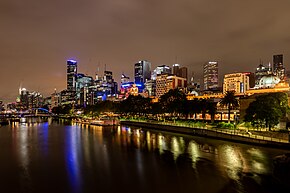
Back Ligbesoedeling Afrikaans تلوث ضوئي Arabic পোহৰ প্ৰদূষণ Assamese Сьветлавое забруджваньне BE-X-OLD Светлинно замърсяване Bulgarian अँजोर प्रदूषण Bihari আলোক দূষণ Bengali/Bangla འོད་ཀྱི་སྦགས་བཙོག་ Tibetan Contaminació lumínica Catalan Světelné znečištění Czech

| Part of a series on |
| Pollution |
|---|
 |
Light pollution is the presence of any unwanted, inappropriate, or excessive artificial lighting.[1][2] In a descriptive sense, the term light pollution refers to the effects of any poorly implemented lighting sources, during the day or night. Light pollution can be understood not only as a phenomenon resulting from a specific source or kind of pollution, but also as a contributor to the wider, collective impact of various sources of pollution.[3]
Although this type of pollution can exist throughout the day, its effects are magnified during the night with the contrast of the sky's darkness. It has been estimated that 83 percent of the world's people live under light-polluted skies and that 23 percent of the world's land area is affected by skyglow.[4][5] The area affected by artificial illumination continues to increase.[6] A major side effect of urbanization, light pollution is blamed for compromising health, disrupting ecosystems, and spoiling aesthetic environments. Studies show that urban areas are more at risk.[7] Globally, it has increased by at least 49% from 1992 to 2017.[8]
Light pollution is caused by inefficient or unnecessary use of artificial light. Specific categories of light pollution include light trespass, over-illumination, glare, light clutter, and skyglow. A single offending light source often falls into more than one of these categories.[9][10]
Solutions to light pollution are often easy steps like adjusting light fixtures or using more appropriate light bulbs. Further remediation can be done with more efforts to educate the public in order to push legislative change.[11] However, because it is a man-made phenomenon, addressing its impacts on humans and the environment has political, social, and economic considerations.
- ^ "Light Pollution". International Dark-Sky Association. Archived from the original on 2021-05-25. Retrieved 2021-06-26.
- ^ Smith, Keith T.; Lopez, Bianca; Vignieri, Sacha; Wible, Brad (2023). "Losing the darkness". Science. 380 (6650): 1116–1117. Bibcode:2023Sci...380.1116S. doi:10.1126/science.adi4552. PMID 37319220.
- ^ "All You Need to Know About Light Pollution". Stanpro. 2018-10-18. Archived from the original on 2021-06-30. Retrieved 2021-06-26.
- ^ Cite error: The named reference
NWAwas invoked but never defined (see the help page). - ^ Pain, Stephanie (March 23, 2018). "There goes the night". Knowable Magazine. Annual Reviews. doi:10.1146/knowable-032218-043601. Archived from the original on March 11, 2021. Retrieved March 26, 2018.
- ^ Kyba, Christopher C. M.; Kuester, Theres; Sánchez de Miguel, Alejandro; Baugh, Kimberly; Jechow, Andreas; Hölker, Franz; Bennie, Jonathan; Elvidge, Christopher D.; Gaston, Kevin J.; Guanter, Luis (November 2017). "Artificially lit surface of Earth at night increasing in radiance and extent". Science Advances. 3 (11): e1701528. Bibcode:2017SciA....3E1528K. doi:10.1126/sciadv.1701528. PMC 5699900. PMID 29181445.
- ^ Han, Pengpeng; Huang, Jinliang; Li, Rendong; Wang, Lihui; Hu, Yanxia; Wang, Jiuling; Huang, Wei (16 June 2014). "Monitoring Trends in Light Pollution in China Based on Nighttime Satellite Imagery". Remote Sensing. 6 (6): 5541–5558. Bibcode:2014RemS....6.5541H. doi:10.3390/rs6065541. ISSN 2072-4292.
- ^ Sánchez de Miguel, Alejandro; Bennie, Jonathan; Rosenfeld, Emma; Dzurjak, Simon; Gaston, Kevin J. (January 2021). "First Estimation of Global Trends in Nocturnal Power Emissions Reveals Acceleration of Light Pollution". Remote Sensing. 13 (16): 3311. Bibcode:2021RemS...13.3311S. doi:10.3390/rs13163311. hdl:10261/255323. ISSN 2072-4292.
- ^ Cite error: The named reference
Kaushik-2022was invoked but never defined (see the help page). - ^ Cite error: The named reference
Chepesiuk-2009was invoked but never defined (see the help page). - ^ Zielińska-Dabkowska, Karolina M.; Xavia, Kyra; Bobkowska, Katarzyna (2020). "Assessment of Citizens' Actions against Light Pollution with Guidelines for Future Initiatives". Sustainability. 12 (12): 4997. Bibcode:2020Sust...12.4997Z. doi:10.3390/su12124997.